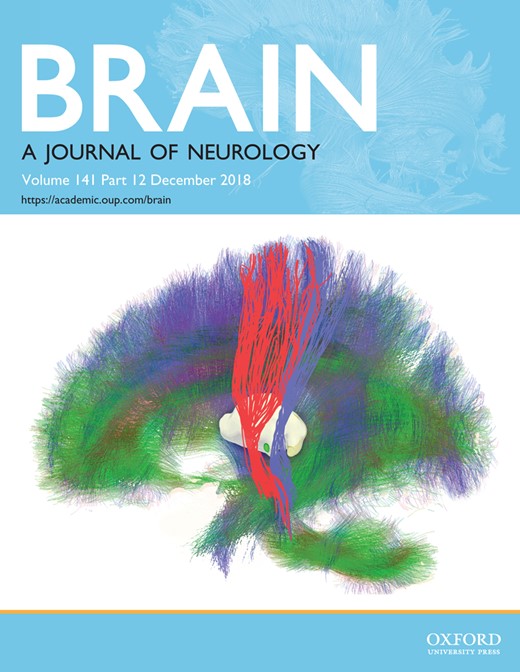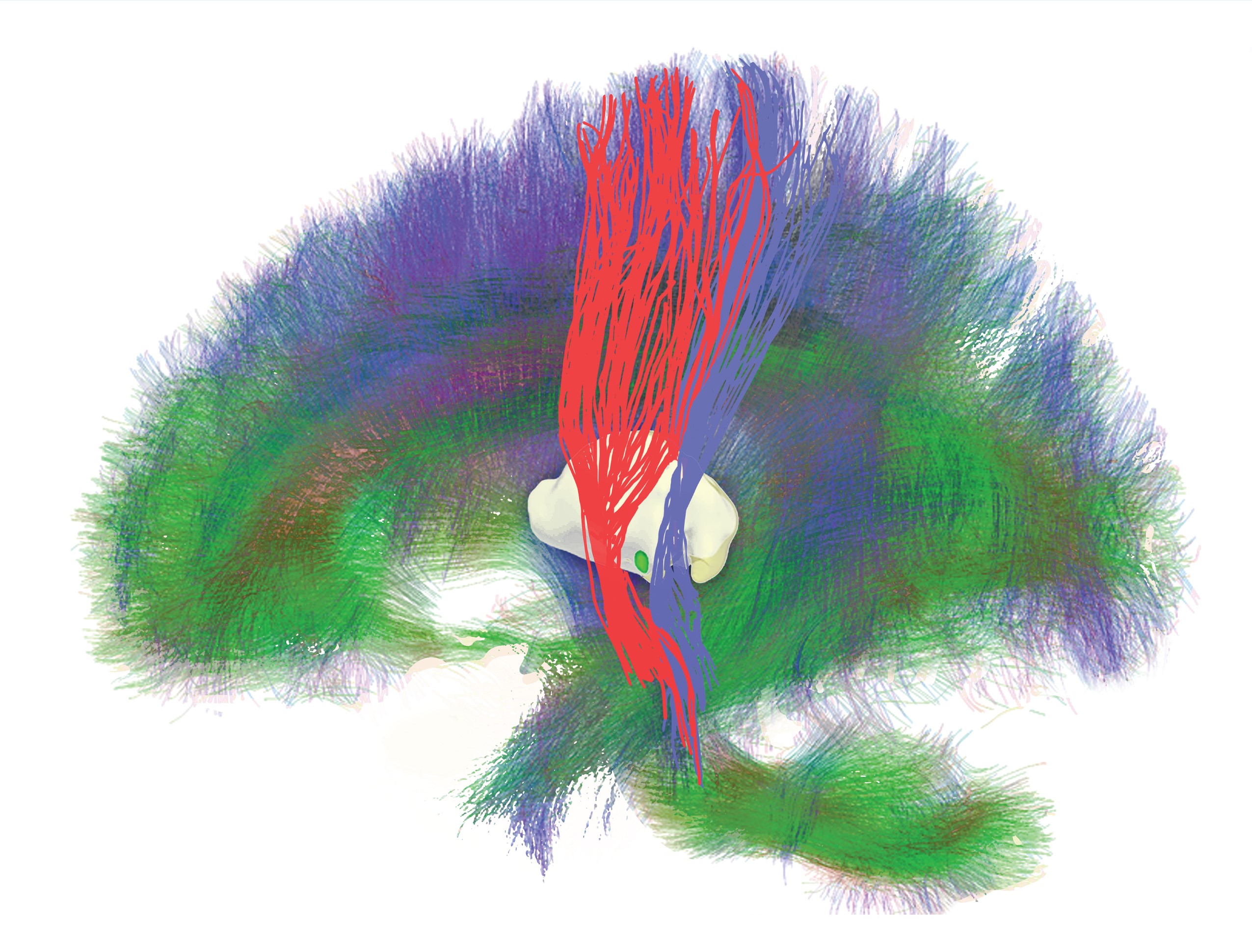
Cover image

Cover image: An imaging review of patients with essential tremor treated with MR-guided Focused Ultrasound (MRgFUS) demonstrates that the optimal target (ovoid green shape) lies within the thalamus (light yellow shading), in between the pyramidal (red) and medial lemniscus (blue) tracts. From Boutet et al. Focused ultrasound thalamotomy location determines clinical benefits in patients with essential tremor. Pp. 3405–3414.
Illustration by Andrew O’Connor.
Volume 141, Issue 12, December 2018
Editorial
Editorial
Scientific Commentaries
That's right! Language comprehension beyond the left hemisphere
This scientific commentary refers to ‘How right hemisphere damage after stroke can impair speech comprehension', by Gajardo-Vidal et al. (doi:10.1093/brain/awy270).
In search of lost trafficking
This scientific commentary refers to ‘Frontotemporal dementia causative CHMP2B impairs neuronal endolysosomal traffic-rescue by TMEM106B knockdown’, by Clayton et al. (doi:10.1093/brain/awy284).
Exploring Alzheimer's disease subtypes at the prodromal stage
This scientific commentary refers to ‘Atrophy subtypes in prodromal Alzheimer’s disease are associated with cognitive decline', by ten Kate et al. (doi:10.1093/brain/awy264).
Brain connections and social connections in autism spectrum disorders
This scientific commentary refers to ‘Local structural connectivity is associated with social cognition in autism spectrum disorder’, by d’Albis et al. (doi:10.1093/brain/awy275).
Review Article
The search for pain biomarkers in the human brain
Do current neuroimaging-based biomarkers developed to ‘objectively’ assess pain perception truly relate to pain? Mouraux and Iannetti critically review the evidence, and examine the utility of brain biomarkers for achieving mechanism-based patient stratification, predicting treatment responses and offering personalized treatments.
Original Articles
A novel ATP1A2 mutation in a patient with hypokalaemic periodic paralysis and CNS symptoms
Sampedro Castaneda et al. describe a boy with hypokalaemic periodic paralysis (hypoPP) and epilepsy without mutations in known risk genes. They show that a de novo mutation in ATP1A2, encoding a Na+/K+-ATPase subunit, gives rise to an inward cation leak current analogous to leak currents seen in other hypoPP cases.
Development and validation of the Charcot-Marie-Tooth Disease Infant Scale
Validated outcome measures for children <3 years with Charcot-Marie-Tooth disease are needed to facilitate clinical trials in a population likely to benefit from early intervention. Mandarakas et al. present a psychometrically robust, reliable and sensitive 15-item functional outcome measure developed via a multicentre study of 128 children.
Spastic paraplegia due to SPAST mutations is modified by the underlying mutation and sex
Mutations in SPAST, which encodes spastin, give rise to spastic paraplegia 4 (SPG4). Parodi et al. present genetic and clinical data for 842 patients and demonstrate that mutation and sex act as phenotypic modifiers. Women show lower penetrance, despite a more severe clinical manifestation, suggesting the existence of protective factors.
Microglial phenotypes in the human epileptic temporal lobe
Using transcriptomics, anatomical studies, imaging and ELISA, Morin-Brureau et al. examine microglia in patients with temporal lobe epilepsies. In highly sclerotic regions such as CA1, the anti-inflammatory cytokine IL-10 regulates microglial phenotype. Seizures induce a transient microglial phenotype associated with secretion of inflammatory cytokines including human CXCL8.
Cognitive control involves theta power within trials and beta power across trials in the prefrontal-subthalamic network
How the prefrontal cortex and subthalamic nucleus coordinate their activity during decision-making is unclear. By recording simultaneously from the two structures, Zavala et al. show that within-trial cognitive control involves theta oscillations, whereas across-trial adaptations involve beta oscillations. The two structures participate in separate, complementary stages of the decision-making process.
Angiopoietin like-4 as a novel vascular mediator in capillary cerebral amyloid angiopathy
Cerebral amyloid angiopathy is associated with vascular remodelling. Chakraborty et al. identify hypoxia-induced angiopoietin like-4 (ANGPTL4), produced by reactive astrocytes, as a novel pro-angiogenic factor involved in this process. Plasma ANGPTL4 has potential as a diagnostic marker for patients with vascular cognitive impairment.
How right hemisphere damage after stroke can impair speech comprehension
See Sheppard and Hillis (doi:10.1093/brain/awy291) for a scientific commentary on this article.
When right hemisphere strokes cause language impairments, it is generally assumed that the patients originally had atypical language lateralisation. Gajardo-Vidal et al. show how impaired speech comprehension can also arise when damage impinges on right hemisphere regions that are required to support speech comprehension even in the absence of atypical lateralisation.
Focused ultrasound thalamotomy location determines clinical benefits in patients with essential tremor
MR-guided focused ultrasound thalamotomy is a novel and minimally invasive ablative treatment for essential tremor. Boutet et al. report that clinical outcomes of this procedure are highly dependent on the location and size of lesions. These findings could refine current procedural methods, thereby improving clinical outcomes.
Early microglial activation and peripheral inflammation in dementia with Lewy bodies
The role of inflammation in dementia with Lewy bodies is unclear. Surendranathan et al. report that microglial activation is elevated in mild disease, before decreasing as cognition declines. Inflammatory markers in the blood are also altered compared to control subjects, suggesting that inflammation could be targeted early in the disease.
Frontotemporal dementia causative CHMP2B impairs neuronal endolysosomal traffic-rescue by TMEM106B knockdown
See Bechek and Gitler (doi:10.1093/brain/awy294) for a scientific commentary on this article.
Mutations in the endosome-associated protein CHMP2B cause frontotemporal dementia (FTD). Clayton et al. report a mechanism for CHMP2B-mediated neuronal dysfunction and a potential therapeutic strategy targeting the TMEM106B gene, a major risk factor for FTD. Targeting TMEM106B may be relevant to a broad range of FTDs.
Atrophy subtypes in prodromal Alzheimer’s disease are associated with cognitive decline
See Kolanko and Malhotra (doi:10.1093/brain/awy282) for a scientific commentary on this article.
Alzheimer's disease is a heterogeneous disorder, and understanding the biological basis for this heterogeneity is key to developing personalized medicine. ten Kate et al. identify atrophy subtypes in patients, and show that these subtypes are present prodromally and are associated with the types of symptoms an individual will develop.
Neurobiological substrates underlying the effect of genomic risk for depression on the conversion of amnestic mild cognitive impairment
Depression increases the risk of conversion from amnestic mild cognitive impairment (aMCI) to Alzheimer’s disease. Xu et al. show that the polygenic risk score for major depressive disorder-specific genetic variants predicts conversion from non-depressed aMCI to Alzheimer’s disease. The underlying mechanisms may involve modulation of hippocampal development and amyloid-beta binding.
Local structural connectivity is associated with social cognition in autism spectrum disorder
See Eyler (doi:10.1093/brain/awy293) for a scientific commentary on this article.
Recent models of autism spectrum disorder (ASD) posit long-range dysconnectivity and short-range overconnectivity. Using a novel method for assessing U-shaped short-distance tracts, d’Albis et al. reveal decreased anatomical connectivity in 13 short tracts in ASD. The reduced connectivity is associated with impaired social cognition, in contrast to current models.
















